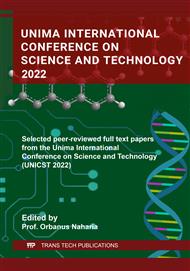p.29
p.39
p.49
p.55
p.63
p.73
p.83
p.93
p.101
An Analysis of Water Quality of Lake Perintis and Lake Limboto as Irrigation Water Sources in Gorontalo Province
Abstract:
This study aims to analyze the water quality of Lake Perintis and Lake Limboto as irrigation water sources in Gorontalo Province. This study was carried out by considering the importance of water from these two lakes for irrigating the rice fields. 2 lakes became the locations for sampling in this study, namely Lake Limboto and Lake Perintis. Because this study was an initial survey, the researchers only applied one-site and one-time sampling for each lake. The observed parameters were temperature, TDS, COD, turbidity, phosphate, pH, nitrate, iron, manganese, cyanide, arsenic, fluoride, chlorine, manganese, magnesium, calcium, sodium, potassium, total coliform, and E. coli. The analysis was carried out at the Water Quality Laboratory, Health Office of Gorontalo and Integrated Research & Testing Laboratory of Gadjah Mada University. The sampling for total coliform was carried out aseptically, while measurements in the laboratory applied the MPN method. The way of taking chemical and physical samples followed SNI 8995-2021. Furthermore, the collected data were analyzed following Government Regulation No. 22/2021 Appendix VI regarding Lake Water Quality Standards. In analyzing water for irrigation purposes, the researchers applied the Sodium Adsorption Ratio (SAR) classification. Results showed that the water quality of Lake Perintis and Lake Limboto did not meet the requirements stipulated in Government Regulation No. 22/2021 because the chlorine, COD, and phosphate parameters were above the required quality standard. In addition, we also found that the pollution level in Lake Limboto was higher than that of Lake Perintis. Moreover, the results of the SAR analysis indicated a score of 7.975 for Lake Perintis (classified in the low sodium criteria) and a score of 11.23 for Lake Limboto (classified in the medium sodium criteria).
Info:
Periodical:
Pages:
63-71
Citation:
Online since:
July 2023
Authors:
Keywords:
Price:
Сopyright:
© 2023 Trans Tech Publications Ltd. All Rights Reserved
Share:
Citation:


